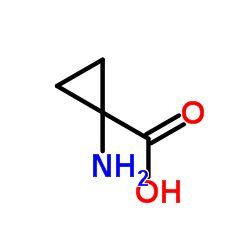1-Aminocyclopropane-1-carboxylic acid

1-Aminocyclopropane-1-carboxylic acid structure
|
Common Name | 1-Aminocyclopropane-1-carboxylic acid | ||
|---|---|---|---|---|
| CAS Number | 22059-21-8 | Molecular Weight | 101.104 | |
| Density | 1.4±0.1 g/cm3 | Boiling Point | 228.9±23.0 °C at 760 mmHg | |
| Molecular Formula | C4H7NO2 | Melting Point | 229-231 °C(lit.) | |
| MSDS | Chinese USA | Flash Point | 92.2±22.6 °C | |
|
Mitogen-Activated Protein Kinase 6 and Ethylene and Auxin Signaling Pathways Are Involved in Arabidopsis Root-System Architecture Alterations by Trichoderma atroviride.
Mol. Plant Microbe Interact. 28 , 701-10, (2015) Trichoderma atroviride is a symbiotic fungus that interacts with roots and stimulates plant growth and defense. Here, we show that Arabidopsis seedlings cocultivated with T. atroviride have an altered root architecture and greater biomass compared with axenic... |
|
|
Chilling-related cell damage of apple (Malus × domestica Borkh.) fruit cortical tissue impacts antioxidant, lipid and phenolic metabolism.
Physiol. Plant. 153(2) , 204-20, (2015) 'Soggy breakdown' (SB) is an internal flesh disorder of 'Honeycrisp' apple (Malus × domestica Borkh.) fruit that occurs during low temperature storage. The disorder is a chilling injury (CI) in which visible symptoms typically appear after several weeks of st... |
|
|
Silicon induces resistance to the brown spot fungus Cochliobolus miyabeanus by preventing the pathogen from hijacking the rice ethylene pathway.
New Phytol. 206(2) , 761-73, (2015) Although numerous studies have shown the ability of silicon (Si) to mitigate a wide variety of abiotic and biotic stresses, relatively little is known about the underlying mechanism(s). Here, we have investigated the role of hormone defense pathways in Si-ind... |
|
|
Implications of ethylene biosynthesis and signaling in soybean drought stress tolerance.
BMC Plant Biol. 15 , 213, (2015) Ethylene is a phytohormone known for inducing a triple response in seedlings, leaf abscission and other responses to various stresses. Several studies in model plants have evaluated the importance of this hormone in crosstalk signaling with different metaboli... |
|
|
Shoot to root communication is necessary to control the expression of iron-acquisition genes in Strategy I plants.
Planta 237(1) , 65-75, (2013) Previous research showed that auxin, ethylene, and nitric oxide (NO) can activate the expression of iron (Fe)-acquisition genes in the roots of Strategy I plants grown with low levels of Fe, but not in plants grown with high levels of Fe. However, it is still... |
|
|
Effect of NMDAR antagonists in the tetrabenazine test for antidepressants: comparison with the tail suspension test.
Acta Neuropsychiatr. 27 , 228-34, (2015) The N-methyl-d-aspartate receptor (NMDAR) antagonist ketamine, produces rapid and enduring antidepressant effect in patients with treatment-resistant depression. Similar dramatic effects have not been observed in clinical trials with other NMDAR antagonists i... |
|
|
Extrapolation of human pharmacokinetic parameters from rat, dog, and monkey data: Molecular properties associated with extrapolative success or failure.
J. Pharm. Pharm. Sci. 94 , 1467-83, (2005) Human pharmacokinetic parameters are often predicted prior to clinical study from in vivo preclinical pharmacokinetic data. Recent data suggest that extrapolation of monkey pharmacokinetic data tends to be the most accurate method for predicting human clearan... |
|
|
GbWRKY1, a novel cotton (Gossypium barbadense) WRKY gene isolated from a bacteriophage full-length cDNA library, is induced by infection with Verticillium dahliae.
Indian J. Biochem. Biophys. 49(6) , 405-13, (2012) WRKY transcription factor proteins play important roles in diverse stress responses. In this study, we first cloned a novel WRKY from our constructed bacteriophage full-length cDNA library for cotton (Gossypium barbadense). The plants were stressed by exposur... |
|
|
Drug design, in vitro pharmacology, and structure-activity relationships of 3-acylamino-2-aminopropionic acid derivatives, a novel class of partial agonists at the glycine site on the N-methyl-D-aspartate (NMDA) receptor complex.
J. Med. Chem. 52 , 5093-107, (2009) Retaining agonistic activity at the glycine coagonist site of the NMDA receptor in molecules derived from glycine or d-serine has proven to be difficult because in the vicinity of the alpha-amino acid group little substitution is tolerated. We have solved thi... |
|
|
Norlittorine and norhyoscyamine identified as products of littorine and hyoscyamine metabolism by (13)C-labeling in Datura innoxia hairy roots.
Phytochemistry 74 , 105-14, (2012) The presence of two compounds, norlittorine and norhyoscyamine, has been reported in leaves and roots of Datura innoxia; however their metabolic origin in the tropane alkaloid pathway has remained unknown. Precise knowledge of this pathway is a necessary pre-... |